Tile roofs are very popular among homeowners in Arizona. Not only do they offer that distinct southwestern desert look to your home, but they are also designed to withstand the heat of the harsh Arizona summers. As a result, these are very durable, but do come with their own set of issues.
One common issue is when tiles become dislodged and fall from your roof. This can indicate one of several problems, and will continue to lead into more problems if not fixed. When tiles fall off of your roof, a small portion underneath is left exposed. When it rains, this is a prime spot for leaks to develop and also allows for the surrounding tiles to lift and fall as well!
Do you live in a new home, or have you recently had a roof replacement? If so, the chances of improper installation are high! If tiles were used that are not rated for the slope of your roof, or if they were not properly secured in place, they may slip and fall.
Unlike shingles which can withstand the weight of someone walking, tiles are easily broken and will likely break or crack under you. Make sure you do not walk on your tile roof – if you have recently had someone service your roof or climb on top for something like a satellite dish installation, then there is a chance something cracked or loosened out of place.
Living in Arizona means you have to deal with intense heat through the summer. Although clay tiles can withstand extreme temperatures and light, they’re not completely immune to it. After some time, it’s worth looking to see if the elements have gotten the better of your tiles – typically clay tiles lay over gaps that could lift up during times of heavy winds, like our current monsoon season!
This may actually be easier than you would expect. The biggest thing you can do to take care of your tile roof is to avoid walking on it unless it is absolutely necessary. Monitor your roof for tiles that look like they are loosening, and if you find any, call a professional roofer to get it taken care of right away. Depending on your home warranty, tile replacements may be covered! Mikku Roofing has over 20 years of experience laying tile and will help to inspect your roof for any damages needing to be fixed. Call today or fill out an online form to get started with a free roof inspection!
Tile roofs can last up to 50 years in Arizona. However, the tile underlayment (felt/ tar paper) typically lasts 20 to 30 years. The tile underlayment will start rotting out when water gets under the roof tiles. Tile underlayment is a roofing material that is installed straight to your roof's decking and acts as a waterproofing membrane.
The most common ways water can get under roof tiles are: clogged valleys/ roof flashing, broken tiles, or the roof tiles not laid properly.
Roof tiles are mainly aesthetic and act as a barrier between the tile underlayment and the roof tile.
The Arizona sun will destroy tile underlayment if it is exposed. Most tile underlayments cannot withstand the UV rays and start deteriorating rapidly.
There are some tile underlayments that are designed for heat and sunny climates such as Arizona’s. So, let’s explore what is the best tile roof underlayment in Arizona!
Many different types of underlayments can be used under concrete tiles in Arizona. Here are the most common: felt (SBS-modified bitumen), synthetic, and self-adhering underlayments.
We will talk about each type of concrete tile underlayment and determine what is best based on several factors: price, waterproofing, durability, and UV resistance.
Synthetic tile underlayments have been increasing in popularity in Arizona. However, in our opinion, they are not the best material to use. Synthetic tile underlayment is a material that is woven together using polypropylene and polymer and has vapor-resistant and water-resistant qualities.
In fact, we will recommend homeowners not choose synthetic concrete tile underlayments. Let’s talk about why we don’t recommend synthetic concrete tile underlayments.
Some synthetic underlayments are more expensive than the felt type of concrete tile underlayments, while other synthetics are cheaper. In fact, the material price can be double that of a felt type of underlayment. Synthetic tile underlayment costs $0.015 to $0.02 per sq. ft and usually comes in rolls that cover 10,000 sq ft at $150,00 - $200 per roll.
It can be cheaper to do two layers of felt than a single layer of synthetic, depending on the brand of material.
Synthetic is the king of waterproofing capabilities and is 100% waterproof. However, synthetics don’t self-seal around fasteners well (nails, staples, etc). This is the biggest issue when installing synthetic underlayment under concrete tile roofs. A concrete tile roof is comprised of
The underlayment is rolled out to cover the deck's surface (keeping it waterproof) and nailed in place.
Batten strips (4 ft sections of 1×2 wood strip) are then nailed or stapled on top of the underlayment. They provide rows for the roof tile cleats to rest on and prevent them from sliding down the roof.
Then the roof tiles themselves.
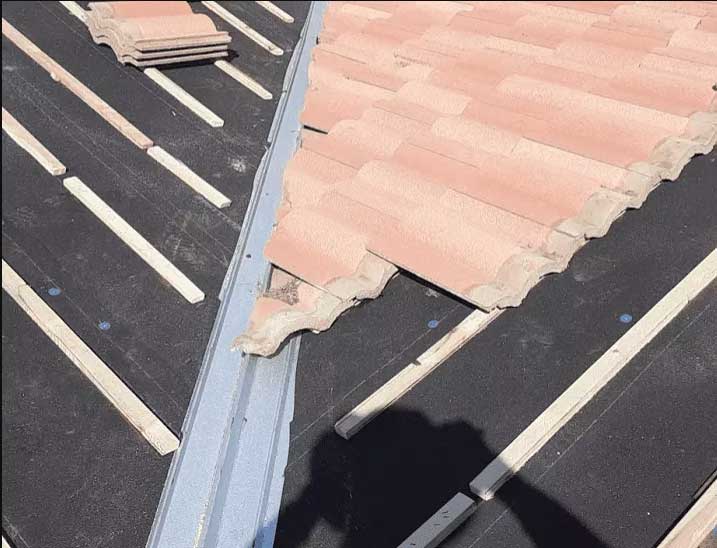
Installing a tile roof requires both the batten strips and underlayment to be fastened to the deck. So, with a synthetic underlayment that doesn’t automatically seal around the fastener’s penetrations, your roof is vulnerable.
The number one reason your concrete tile roof leaks is from water getting under the batten strips and going through the fastener's penetrations.
Rubber-modified felt papers will automatically seal these penetrations while synthetics will not.
So even though synthetics have a 50 years product warranty they are not the best tile underlayment for sealing the around the roof fasteners.
As far as durability, synthetic roof material is quite durable. However, when synthetic tears it tends to tear in big sections. Synthetic concrete tile underlayments have a durable surface for foot traffic and have an excellent non-slip surface
Synthetic underlayment has very strong UV-resistant qualities. When exposed to the direct sun, the underlayment can maintain a UV resistance from 6 to 12 months
This underlayment is different from both the synthetic and felt underlayment because it has a self-adhering bottom. When installing a thin film is pulled away and the self-adhering bottom adheres to the roof's deck.
The gives the advantage of leaving no roof fasteners (cap nails) exposed.
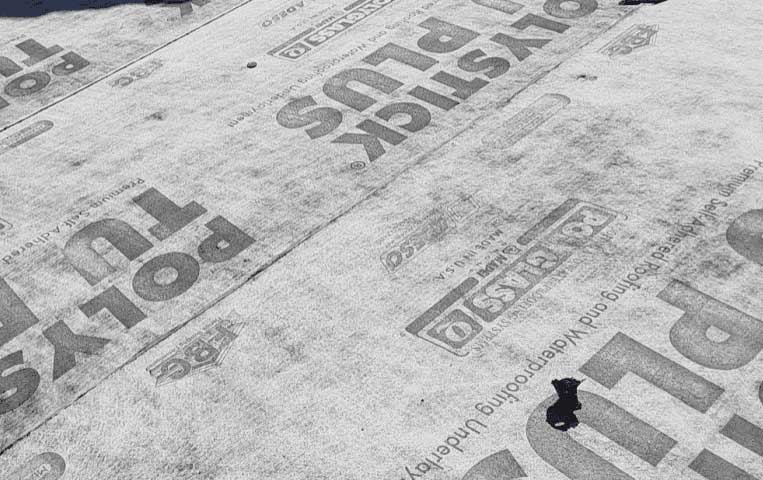
Another benefit is most of the self-adhering concrete tile underlayments are rubber-modified and automatically self-seal around any nails pounded through its surface.
Self-adhering concrete tile underlayments are generally more expensive. Self-adhering tile underlayment also called rubberized asphalt roofing underlayment, is $0.05 to $0.075 per sq. ft and costs $100 - $150 per roll that covers 2,000 sq ft. Note: this is just the material price and not what it costs for installation. It is usually around the same price to use synthetic underlayment.
This concrete tile underlayment is excellent at waterproofing. It has a lot of rubber inside of it and lasts a very long time. The seams are adhered together providing a waterproof surface.
Self-adhering concrete tile underlayment is the most durable underlayment available in Arizona. Specifically, the brand, Boral Tile Secure, is the best concrete tile underlayment in Arizona for the durability factor. It can be used under metal roofs so it has a very high melting point.
The surface is non-slip and can handle high foot traffic which is good for the installers!
This material can handle a lot of UV exposure and lasts up to 6-12 months of direct Arizona sun! For UV Resistance, self-adhering underlayment is the best underlayment for tile roofs in Arizona
Felt-style underlayments have been around the longest out of the other two types. They are different classes and types of felt that are used under concrete tiles in Arizona. This material is a blend of cellulose, asphalt, polyester, and bitumen soaked in a waterproofing agent. In layman's terms, it is felt paper saturated with asphalt.
Felts thicknesses are organized by weight classes ranging from 30# to 90#. Some felts are better than others.
Organic felt tile underlayment was used a lot 20 to 30 years ago. However organic felt is the cheap option. It tends to dry up and curl on the seam edges with age.
Also, there have been incidences where roof rats have chewed up all the organic felt paper under tile roofs causing the roof to leak severely.
The better felts are the SBS Rubber modified bitumen. They are fortified with rubber which helps the underlayment lay flat on installation. The rubber also helps the material to self-seal around the roof fasteners.
The price for SBS rubber modified bitumen is the cheapest out of the other two options. In many cases, it is costs less to apply two layers of SBS rubber modified felt than one layer of synthetic or self-adhering underlayment.
For the price, felt is the best underlayment for tile roofs in Arizona, and costs around $30-$40 per roll and each roll cover around 4000 sq ft, which means it costs $0.0075 to $0.01 per sq ft. Note: this is just the material price and not what it costs for installation.
Organic felt is not 100% waterproof, but the SBS-modified version has more rubber, allowing it to be more water proof than the organic felt.
In Arizona, we have a very dry climate so SBS modified felt papers are more than enough to keep your roof dry.
The composition of the SBS prevents it from rotting and deteriorating like its organic cousin.
Felts are quite durable and can handle foot traffic quite well. The organic felts are less durable than SBS-modified felts.
However, if the felt is installed in high temperatures the asphalt becomes pliable and the tar paper can slide when being installed. This is a hazard for the roofers since the tile roofs have a pitch.
Both the self-adhering and synthetic concrete tile underlayments have better UV resistance than felt. If a tile breaks on your tile roof and exposes the surface of the underlayment it is advised to get the tile replaced as soon as possible.
The SBS-modified felts are generally more UV resistant than the organic felts. Felt does not win the UV resistance test for underlayments in Arizona.
The synthetics are out ruled out being that they are not self-sealing when a nail is pounded through their surface. In fact, we would NOT recommend synthetics under tile at all for Arizona. It is the best underlayment for under shingle roofs in cold climates.
One of the biggest faults synthetics have is not being repairable. One of the other two options is if there is a premature leak then they can easily be repaired with more felt and tar.
Many times a tile roof starts leaking in a high water flow area years before the rest of the underlayment needs to be changed. In our opinion synthetics is one of the worst underlayments for tile roofs in Arizona.
While self-adhering underlayment is the best tile underlayment in Arizona for durability, length of life and UV resistance, an SBS rubber-modified felt is our pick.
The particular brand that we like the most is TU-43. Tu-43 lasts a long time, it can easily be repaired, has a rubber and fiberglass core, and it is has a reasonable price tag.
However, Boral Tile Seal would be our pick for the best self-adhering tile underlayment in Arizona. It just comes at a higher price.
Installing two layers would be cheaper than one layer of the self-adhering underlayment and last around the same time (some cases even longer).
So, if you need the underlayment replaced under your tiles in Arizona then we would recommend TU-43 as the choice of tile underlayment material. In our opinion, TU-43 is the best underlayment for tile roofs in Arizona!
We’re guessing if you are reading this blog, you likely either already have a leaking concrete tile roof or you have one that is old and likely to begin leaking soon. Read on for tips on how to detect leaks in concrete tiles roofs and what the importance of replacing the underlayment is once it goes bad.
The underlayment that’s used on concrete roofs will typically last you around 20-30 years, although it is heavily dependent on what kind of material was used. Most of the track-style homes across the valley use 30# underlayment, which is the thinnest underlayment allowed according to roofing code, and will last approximately 20-25 years.
If you know that your roof is approaching this age, or is over 20 years old already, then there’s a good chance leaks will start to show up sooner than later. Many leaks go undetected until it’s too late, especially if they are found in harder to see locations like on the eves or gable edges of a roof. A good sign that there’s a leak is to walk around the base of your roof and look upwards at the underside – any signs of water staining are an immediate sign you should have your roof checked.
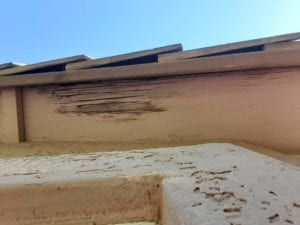
Being proactive means that you are acting in advance before damages are done. Rather than be reactive when fixing your roof, having a proper maintenance plan in place can greatly reduce the effects caused by unseen damages. Things this will help to avoid include dry wall repairs caused by leaks, repainting stained ceilings, removal of mold and still water, and more.
To give an idea of what replacing concrete tile roof underlayment may look like, we’ve included some pictures from a smaller repair. Remember, when it comes to your roof, repairs should be made quickly before the damage is too late to fix!
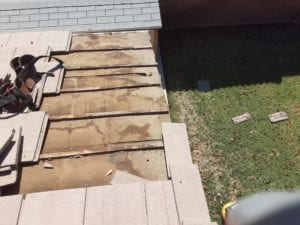
1. Concrete roof tiles are removed:
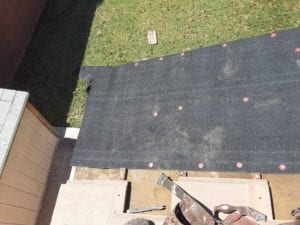
2. Remove Battens strips , clean surface free of debris and install tile underlayment:

3. Install new Batten Strips:
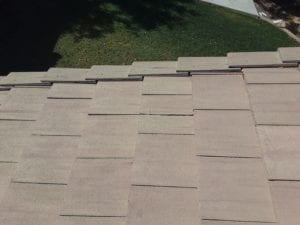
4. Reinstall roof tiles and replace any broken ones:
Tile roofing is most commonly installed on Southwest and Mediterranean-style homes. These aesthetically pleasing tiles are generally made of clay, concrete, or slate.
However, the benefits of a tile roof are more than just good looks; choosing the right tile can help improve the house's value and help when you sell your house.
Familiarize yourself with the selling points that make them such popular roofing options. Weigh those strengths against key factors to decide whether or not your home can benefit from a tile roof. You
(See our tile innovations post)
Clay, concrete, and slate roofs are extremely resistant to fire and resist rot, bugs, and most other pests. Most tile roofing will hold up to extreme heat and cold, making it great for use in almost any climate. Usually, the underlayment needs to be replaced every 20 years. This is how underlayment is replaced.
Clay tiles are especially resistant to corrosion from the salty air, which makes them an excellent choice for properties located in coastal areas.
Many kinds of roofing tiles can also brag of superior impact resistance, which makes them a superior option in areas that experience severe storms with hail or high winds.
Most tile roofs are found in the warmer regions of our country, but they can be utilized in colder areas, too.
When you’re installing a clay or concrete tile roof in a region with a colder climate, however, you should require materials designed to handle the expansion that occurs with freezing and thawing cycles.
Quite frankly, people are the biggest threat to tile roofs. The tiles are not typically designed to handle foot traffic and are prone to be being broken or chipped when people walk on them and are careless.
This is why it's important to hire an experienced, professional roofing contractor to do any repairs or maintenance on or around a tile roof – including cleaning gutters, maintaining chimney and other protrusion flashing, and routine regular inspections.
A roof made of concrete, clay, or slate could be the last roof you will ever need on your home. Clay or slate tiles can last as long as 100 years, while most concrete tile comes with a 50-year warranty.
Slate is one of the most durable and long-lasting roofing materials of all, with a lifespan of 100 to 150 years or more.
Concrete and clay tiles usually feature natural earth tones, a sand-cast or unglazed finish, and a classic curved shape.
However, their design isn’t limited to just these Southwestern and Mediterranean benchmarks. Their casting allows for a lot of different style options which will suit just about any type of architectural taste.
Both concrete and clay tiles come in a large array of colors and can have glazed or unglazed finishes. The most common shapes are flat, fluted, and interlocking which can be used in a wide variety of home designs.
Some tiles are made to look like wood shakes, for use in craftsman, rustic, and log homes. Others are designed to mimic traditional European properties.
Natural slate tiles are used often as the roofing system of choice for victorian, colonial, and Tudor architecture. They also look great on sleek, modern, contemporary homes.
Slate tiles give the distinct appearance of natural stone and have a lot of advantages that clay and concrete tiles have, including durability and long lifespans.
They’re very popular in northern Europe and are often found in victorian and Tudor-style homes in the US.
Tile roofs are one of the most expensive upfronts for both materials and labor. Slate, as an example, can range from $1,000 to $2,000 per square (which is a 10-foot-by-10-foot section of roofing) installed and a tile roofing contractor that has experience working with the high-end material may also require more.
However, over their long lifespan, concrete, clay, and slate tiles will offset their initial cost. Because of a high thermal mass, tiles do a great job of regulating the temperature of your property, thus helping you lower heating and cooling expenses.
The durability and longevity of clay, concrete, and slate also mean that you save a lot of money by not having to replace your roof multiple times over the lifespan of your home.
As an added benefit in today's eco-friendly world, all of the materials used are environmentally friendly, easily recycled.
However, like any great roofing system, there are drawbacks and problems. For example, the trim tiles fall off after a while.